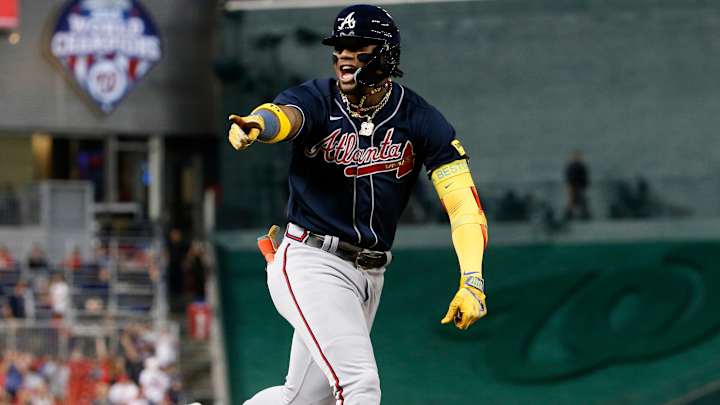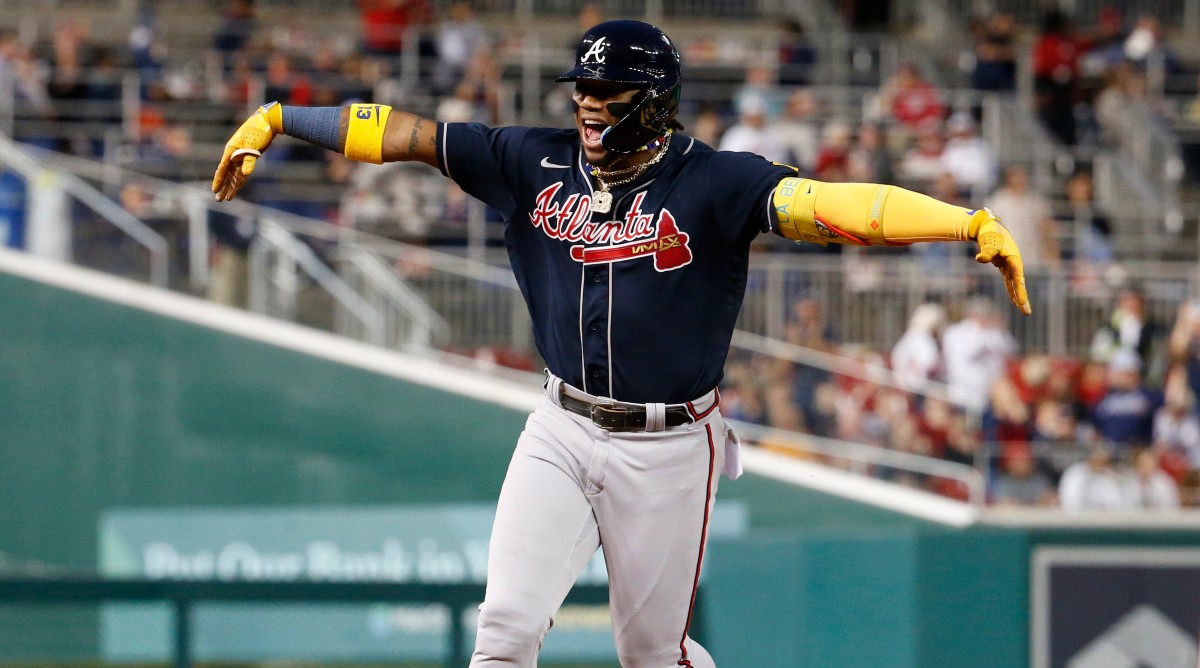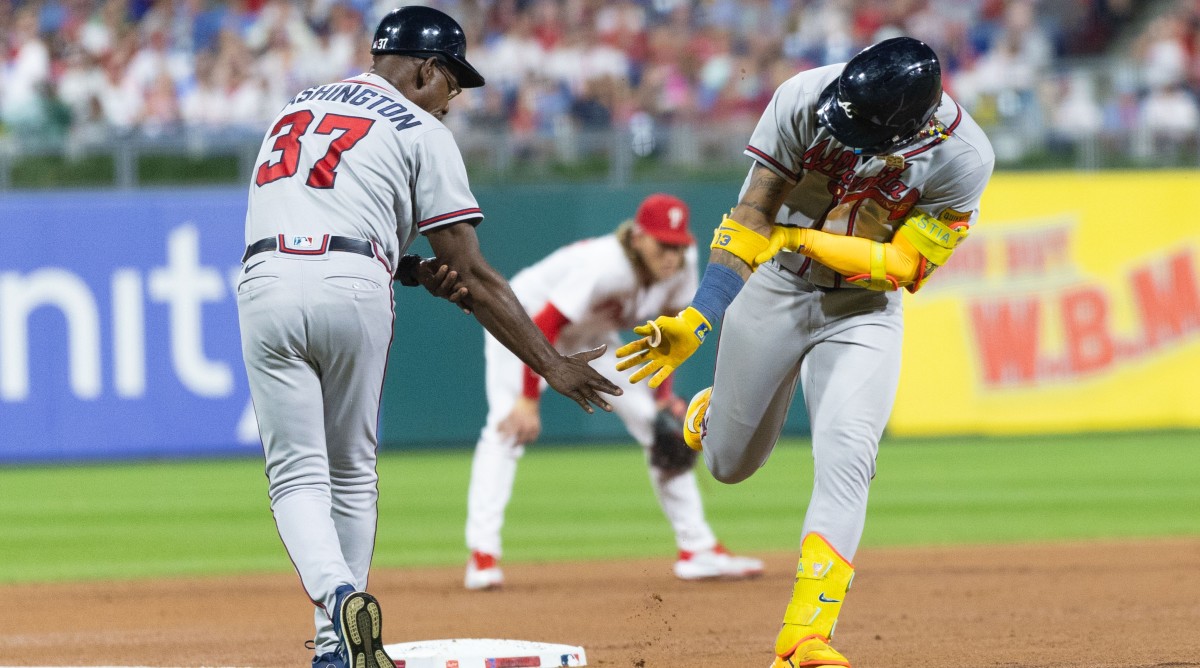A Base-by-Base Guide to Ronald Acuña’s Electrifying Home Run Trots

Braves right fielder Ronald Acuña Jr. was the most electric player in the sport this year, and his feats were not limited to the actual playing of baseball.
He can also celebrate a home run like no one else.
The average Acuña home run trot takes 26.4 seconds, 12th-longest among players with more than 20 dingers, and each instant of that span is must-watch. As a national audience tunes into Atlanta’s chase for its second World Series title in three years, fans may need some help to understand what they are seeing.
Ronald cleared for 𝐭𝐚𝐤𝐞𝐨𝐟𝐟🚀 pic.twitter.com/dR8XCRFO9Z
— Bally Sports: Braves (@BravesOnBally) August 16, 2023
HOME PLATE
There is one single moment of stillness, just after Acuña finishes his follow-through, and it is that moment that catcher Travis d’Arnaud likes most. He does not bother to watch the ball go. Instead he scrutinizes Acuña’s face. “He knows before anybody if it’s gone or not,” d’Arnaud says. Acuña breaks out into a grin and begins stalking toward first, usually with a bat flip on the way. This can range from a demonstrative fling to a gentle toss, and for most players it would be the highlight of the celebration. But Acuña is just getting started.
FIRST BASE
As he nears first base, he points to first base coach Eric Young Sr. and shakes his hand. Acuña often adds a chef’s-kiss gesture, which third baseman Austin Riley loves. “It’s subtle,” he says. “But I don’t think anyone [else] has ever done it.” He says he has no idea what it means. Neither does Acuña. “I don't know why I do it,” he admits with a laugh through interpreter Franco García. “It's just one of those things that I go out there and run, and that's what happened.”
As he passes first base, Acuña turns to his dugout and flaps his arms like wings, a celebration outfielder Kevin Pillar and pitcher Kirby Yates devised as a nod to the Call of Duty games Atlanta plays together on the road. (In the first scene of the video game, players drop from a helicopter; in the baseball game, they hope the ball will drop in for a hit.)

“I’m coming around,” says Pillar. “I think I was very, like, vanilla when it came to celebrating, kind of, I guess, a little old-school. But I realize that everyone comes from a different background, whether it’s in the States or foreign, and the way they play baseball is a little different. I got an opportunity to play in the Dominican Republic, and I know the passion and energy and fun. And it should never be taken as disrespect for the [other] team but more as a way of having fun and bringing energy to your own squad. It took me a while to catch onto that, and I feel like that’s something Ronald does really well: I don’t feel like it’s ever addressed towards the other team to show a pitcher up. It’s more to celebrate his individual accomplishment but [also] an accomplishment for our team and to create some energy, and it’s fun to watch.”
It’s the grin that infielder Nicky Lopez most enjoys. “He plays with such joy and such passion,” he says. “Some people might call it cocky, arrogant, whatever it is, but I think it’s more just [that] he’s happy.”
SECOND BASE
As he crosses second base, Acuña is supposed to point to the bullpen, a tradition the Atlanta hitters started last year to acknowledge the over-the-top excitement the relievers display on big plays. They jump on the rail and holler. But in the chaos, Acuña does not always remember. “He’s been a little iffy about giving the bullpen love,” says reliever A.J. Minter gravely. “Just a point. That’s all we need.” He laughs and adds, “He’s hit some pretty clutch ones recently, so I can’t blame him.”
THIRD BASE
Just before he hits third base, he does a Eurostep in honor of Tigers DH Miguel Cabrera, a fellow Venezuelan who retired this year and who made the side-to-side basketball move a part of his own home run celebration.
Then Acuña heads for third base coach Ron Washington, who has to steel himself for impact. Three decades of hitting fungoes has left Washington with a shredded right shoulder, so he braces his right elbow with his left hand and extends the arm for a low five. “I don’t want him to push my shoulder back,” Washington explains. “Ronald is just an excitable person.” Washington is a little excitable, too—he generally dashes toward Acuña. (Incidentally, this is Young’s favorite part. “Mine, that’s what I do with everybody,” he says. “What he does with Wash, that’s one on one.”)

At this point Acuña crosses himself, does Atlanta Hawks point guard Trae Young’s “ice cold” mock shiver or Memphis Grizzlies point guard Ja Morant’s “too small” reach toward the ground, and points to the sky.
HOME PLATE
As he nears the plate, Acuña has time for one more Eurostep, again in honor of Cabrera. And then he does manager Brian Snitker’s favorite part of the trot: “When he crosses home,” the manager says with a laugh. “It’s a run!”
